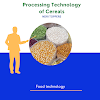Biological factors involved in deterioration
1. Respiration
2. Ethylene production
3. Temperature
4. Water loss
5. Physical damage
6. Physiological breakdown
Respiration
Respiration is the process by which stored organic materials(carbohydrates,proteins, fats) are broken down into simple end products with a release of energy.
During respiration,oxygen (O2) is used
and carbon dioxide(CO2) is produced.
Respiration involves degradation of food reserves,especially sugars, in order to produce chemical energy (in the form of ATP and NADH) needed to maintain cellular metabolic activity.
• When glucose is used as a substrate, the
equation for respiration is:
C6H12O6 + 6 O2 → 6 CO2 + 6 H2O +kcal heat
Commodities with high respiration rates will have short potential storage lives.Commodities with low respiration rates will have long potential storage lives
2
Ethylene:
Ethylene is a colorless gas that is naturally produced by plants and functions as a plant growth regulator. In this way, ethylene behaves in the same way as hormones in mammals.It triggers specific events during a plant’s natural course of growth and development, such as ripening. Through this action, it induces changes in certain plant organs, such as textural changes, color changes, and tissue degradation.
Some of these changes may be desirable qualities associated with ripening; in other cases, it can bring damage or premature decay.
Impacts of ethylene on post harvest quality of fruits and vegetables
• Yellowing or loss of green color (for example, in
cucumber, broccoli, kale, spinach)
• Increased toughness
• Increase or decrease sprouting in potatoes
• Yellowing and abscission (dropping) of leaves
• Softening, pitting, and development of off-flavor in peppers, summer squash, and watermelons
• Browning and discoloration in eggplant pulp and seed
• Discoloration and off-flavor in sweet potatoes
• Increased ripening and softening of mature green tomatoes
• Development of bitter taste in carrots and parsnips
Steps to reduce ethylene exposure during
storage
• Do not store or transport green leafy vegetables in
containers holding ripening fruit (apples, pears, mangoes,
tomatoes, bananas).
• If possible, use electric powered equipment in storage areas
versus gas powered.
• Remove overripe or rotting fruit from storage loads (these
produce higher amounts of ethylene).
• Avoid storing ethylene sensitive products with products that
produce high levels of ethylene.
• Increase the ventilation rate of the storage area, assuming
that the outside air is ethylene free.
• Use ethylene scrubbers in storage areas to remove ethylene
in the air.
Temperature
Temperature has a direct effect on the respiration rate of the product and this is an indication of the rate of deterioration of the product. Temperature also affects the rate of growth of postharvest rots
For every 10oC increase in temperature the rate or respiration is roughly doubled or even trebled This increase in respiration has a direct impact on the shelf life of fresh products.
Water loss
Water loss is a main cause of deterioration because
it results in:
● Direct loss of salable weight
● Loss in appearance (wilting and shriveling)
● Loss of textural quality (softening, crispness)
Small fruit have large surface-to-volume ratios, and
especially suffer from water loss!
5. Physical Damage
Physical damage (surface injuries, bruising, vibration damage) is a main contributor to deterioration. The damaged areas become brown (because leakage of phenolic compounds), accelerate water loss, stimulate ethylene production, and provide sites for pathogen invasion.
















0 Comments
Send feedback